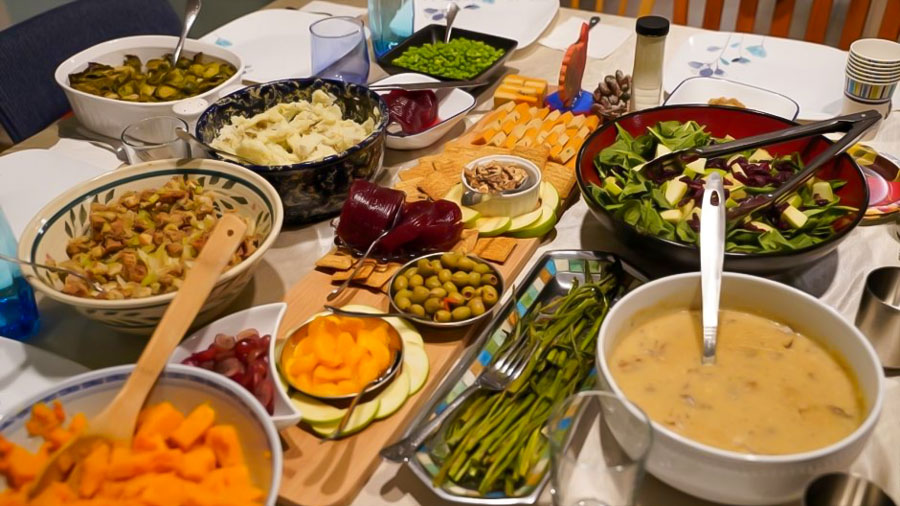This season, take note of the bounty on your plate. What's it all about?

Some may think the sage-spiced stuffing and baked apples are just yummy people food, but plants, as someone once said, have their own secret life and purpose. For instance, did you know you'll be eating ovaries, forbidden fruit and an arsenal of defense mechanisms?
Try apples, oranges, squash and cukes, even peas and green beans – all fruits with edible ovaries. In fact, any fruit or “vegetable” that normally contains seeds is a fruit, and the ovary is the fleshy, mature, delicious part.
So Professor Pamela K Diggle, Dept. of Ecology and Evolutionary Biology, University of Colorado, reviews plant structure with her Plant Anatomy class just before Thanksgiving break.
"This started as a fun thing to do at a class that I teach about cells and tissues and organs of plants. We’re eating organisms. It’s fun to think about the characteristics of the food we’re eating that make them part of this traditional meal, and what constitutes the amazing smells and textures and cooking qualities of these plants that contribute to the feast,” she says.
“When you think about almost any meal, no matter how much of a committed carnivore you are, we really depend on plants to bring out the flavor in everything. You don’t sit down and eat just meat. Most things invariably have spices on it that contribute to the flavor of whatever you’re cooking, and they’re derived from plants.”
Diggle enjoys exploring the biology of food, their uses, sources and what they look like under a microscope.
Take sage that everyone enjoys in stuffing. The oils that give sage its distinctive aroma and flavor are synthesized in hairs on the surface of the leaf. The grey color and soft texture of the leaves are from those hairs.
Plants use a lot of aromatic oils that we use as seasonings as defensive compounds to repel critters that are trying to eat them, says Diggle. Often these aromatic oils are allelopathic, inhibiting the growth of other plants to reduce competition for resources. The oils secrete from where they’re produced in the hairs, or the oils and compounds get in the soil when the leaf drops (such as black walnut).
“The odor of cabbage and broccoli is really cool” says Diggle. What cabbages do – this is anti-herbivory mechanism. Cabbages have two chemicals in their cells that are separated by a structure. A bite crushes the structure inside the cell and the two chemicals mix. As they mix they release toxic mustard oil that creates a chemical reaction that deters herbivory.
“The two chemicals are completely harmless when they’re separated, but when they mix they make a toxic mustard oil. It can kill an herbivore. My understanding is that if cattle get into a field of rapeseed, a relative of cabbage, they get really sick. A lot of things in the mustard family that we eat have been selected to get rid of a lot of that, but still that distinctive odor comes from that same reaction,” she says.
What are plants trying to do with these tastes and colors that we love so much? Some plants use taste and color to NOT be eaten. Others, such as cranberries and pumpkins with beautiful colors or sweet flavors, use taste and color to manipulate humans and other animals to eat them and disperse their seed.
“The things that we do with the plants may actually be how plants manipulate animals into dispersing them,” Diggle says.
Starchy things like potatoes appeal to people. Potatoes are really storage organs for the plants. “We eat them for nutrition but they are essentially nutrition that the plant has put aside to nourish itself so we are taking advantage of the plant’s thriftiness and storage. We store fat; plants store starch.”
The leaves of turnips, carrots and other roots die back over winter but, in warm enough climes, the plant may resprout in spring using the nutrients stored in the roots or tuber.
The botanical definition of a fruit is that it’s a mature ovary of the plant. The sweet taste of an apple is probably the result of natural selection. Apple seeds contain cyanide as do many seeds in the rose family. It may be a protection of the plant not to eat the seed but just to disperse it.
Ever wonder why dried beans take so long to cook? Partly it’s because the starch and protein take a long time to break down. If you see the covering of the bean come loose and the bean swells, it demonstrates another reason – self-preservation.It’s a mechanism that beans use to not germinate at the wrong time and why it takes them a long time to swell.
The skin of the bean is a tight layer of almost waterproof cells, which makes water absorption extremely difficult. That prevents them from germinating until there is sufficient water to sustain growth. (Similar to serotinous plants, like pitch pine, that need fire to sprout.) Some wild legumes won’t germinate unless their hard coat is mechanically damaged. Think of plants that grow in very dry areas and are damaged by a flash flood, which is a signal that there’s enough water to get started.
Really hard nuts like walnuts are similar to beans. Their shell almost feels like wood with similar types of cells, though their purpose is different. This hard covering requires a lot of damage or a lot of water to allow the embryo inside to germinate.
This Thanksgiving, take a look at the plants on your table and think about what they try to do with color, scent, taste and texture.